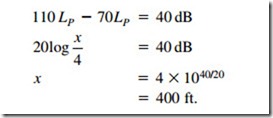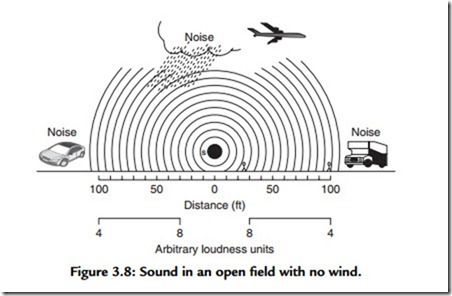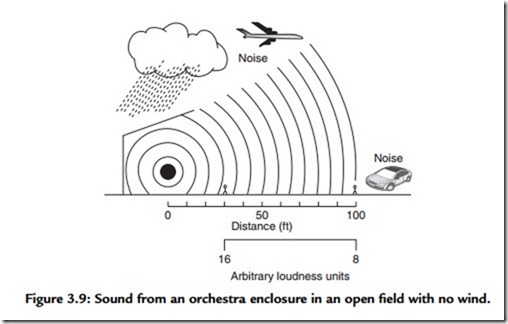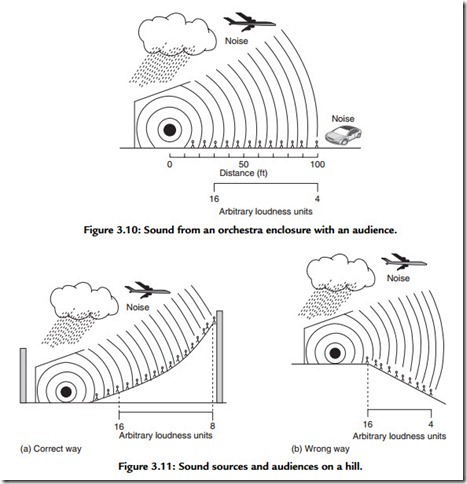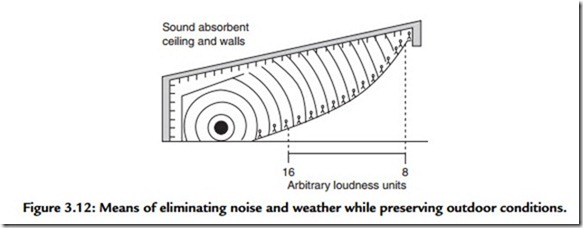Classifying Sound Fields
Free Fields
A sound field is said to be a free field if it is uniform, free of boundaries, and is undisturbed by other sources of sound. In practice, it is a field in which the effects of the boundaries are negligible over the region of interest. The flow of sound energy is in one direction only. Anechoic chambers and well-above-the-ground outdoors are free fields. The direct sound level from a sound source in a free field is labeled LD.
Diffuse (Reverberant) Fields
A diffuse or reverberant sound field is one in which the time average of the mean square sound pressure is the same everywhere and the flow of energy in all directions is equally probable. This requires an enclosed space with essentially no acoustic absorption. The reverberant sound level is labeled LR.
Semireverberant Fields
A semireverberant field is one in which sound energy is both reflected and absorbed. The flow of energy is in more than one direction. Much of the energy is truly from a diffused field; however, there are components of the field that have a definable direction of propagation from the noise source. The semireverberant field is the one encountered in the majority of architectural acoustic environments. The early reflections, that is, under 50 ms after LD, are labeled LRE.
Pressure Fields
A pressure field is one in which the instantaneous pressure is uniform everywhere. There is no direction of propagation. The pressure field exists primarily in cavities, commonly called couplers, where the maximum dimension of the cavity is less than one-sixth of the wavelength of the sound. Because of ease of repeatability, this type of measurement is used by the National Bureau of Standards when they calibrate microphones. At low frequencies the pressure field can be large, that is, big enough for a listener to sit in.
Ambient Noise Field
The ambient noise field is composed of those sound sources not contributing to the desired LD (i.e., active sources). The ambient noise level is labeled LN.
Outdoor Acoustics
If, for example, the ambient noise level measured 70 dBA (not an unreasonable reading outdoors) and the most SPL you could generate at 4 ft was 110 dB LP, how far could you reach before your signal was submerged in noise?
The problem actually is more complicated than this outdoors, but this serves as an illustration of how to begin.
We have now touched on the most important basics of the acoustics environment outdoors. Before going indoors, let us apply some of this knowledge to a series of ancient outdoor problems. A simple rule of thumb dictates that when a change of +10 dB occurs, the higher level will be subjectively judged as approximately twice as loud as the level 10 dB below it. While the computation of loudness is more complex than this, the rule is useful for midrange sounds. Using such a rule, we could examine a sound source radiating hemispherically due to the presence of the surface of the earth. Figure 3.8 shows sound in
an open field with no wind. The sound at 100 ft is one-half as loud as that at 30 ft, although the amplitude of the vibration of the air particles is roughly one-third. Similarly, the sound at 30 ft is one-half as loud as the sound at 10 ft. Because the sound is outdoors, atmospheric effects, ambient noise, and so on cause difficulty for the talker and listener. The ancients learned to place a back wall behind the talker, and many Native American council sites were at the foot of a stone cliff so that the talker could address more of the tribe at one time. Figure 3.9 illustrates how a reflecting structure can double the loudness as compared to totally open space. The weather and some noise still interfere with listening.
Figure 3.10 illustrates the absorptive effect of an audience on the sound traveling to the farthest listener. Figure 3.11 shows the right way and the wrong way to arrange a sound source on a hill. In Figure 3.11(a), the loudness of the sound at the rear of the audience is enhanced by sloping the seating upward. In addition, the noise from sources on the ground is reduced. Figure 3.11(b) is a poor way to listen outdoors.
While the Bible doesn’t say which way Jesus addressed the multitudes, we can deduce from the acoustical clues present in the Bible text that the multitude arranged themselves above him because:
1. He addressed groups as large as 5000. This required a very favorable position relative to the audience and a very low ambient noise level.
2. Upon departing from such sessions, he could often step into a boat in the lake, suggesting that he was at the bottom of a hill or mountain.
We can further surmise that the reason Jesus led these multitudes into the countryside was to avoid the higher noise levels present even in small country villages.
The Greeks built their amphitheaters to take advantage of these acoustical facts:
1. They provided a back reflector for the performer.
2. They increased the talker’s acoustic output by building megaphones into the special face masks they held in front of their faces to portray various emotions.
3. They sloped the audiences upward and around the talker at an included angle of approximately 120°, realizing, as many modern designers do not seem to, that humans do not talk out of the back of their heads.
4. They defocused the reflective “slapback” by changing the radius at the edges of the seating area.
Because there were no aircraft, cars, motorcycles, air conditioners, and so on, the ambient noise levels were relatively low, and large audiences were able to enjoy the performances. They had discovered absorption and used jars partially filled with ashes (as tuned Helmholtz resonators) to reduce the return echo of the curved stepped seats back to the performers. It remained only for some unnamed innovative genius to provide walls and
a roof to have the first auditorium, “a place to hear” (Figure 3.12). No enhancement of sound is provided in Figure 3.12 because there is no reverberation in a room whose walls are highly sound absorbent.
Sometimes acoustic progress was backward. For example, the Romans, when adopting Christianity, took over the ancient echo-ridden pagan temples and had to convert the spoken service into a chanted or sung service pitched to the predominant room modes of these large, hard structures. Today, churches still often have serious acoustical shortcomings and require a very carefully designed sound system in order to allow the normally spoken word to be understood.
It is also of real interest to note that in large halls and arenas the correct place for the loudspeaker system is most often where the roof should have gone if the building had been designed specifically for hearing. A loudspeaker is therefore usually an electroacoustic replacement for a natural reflecting surface that has not been provided.
